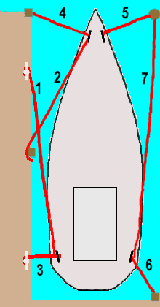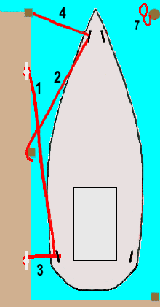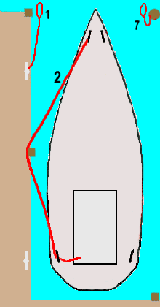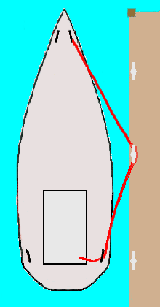
Sailing the Catalina 320 Single Handed
~~ Paul V. Hartman ~~
Part I - Departure
First Do A Boat Check
A Checklist is handy - refer to Appendix A which reviews the things you should check before doing anything else.
Preparing Your Boat For Departure
In the cabin, test both batteries for charge. Set the battery switch to ALL so that both will charge when the diesel is running. Switch on the in-cabin 25watt VHF, set on 16. (The bilge switch should always be On.) Switch On Speed and Depth and other instruments at the helm. Switch on Autopilot if you have one. Be sure the hatches are closed as you may either step into them or snag a genoa sheet on them. Gather up any flags you wish to fly. If you keep the boat hook below, bring it topsides.
For personal safety and protection of your boat, once you are in motion, you will want to reduce the number of reasons to go below or to go forward - anything that takes you away from the safety and control of being at the wheel. Some of those reasons can be performed before you leave the dock, such as making sure that life vest, cushions, hand-held VHF, hand held GPS, charts, winch handles, cold drinks and a sandwich, binoculars, etc., are already in the cockpit, and the proper panel switches are "On".
On deck, remove the mainsail cover. Attach the halyard to the head of the mainsail; be sure it is firmly locked. Stow all fenders except those needed for departure. (My harbor has a lock, for which I need fenders after I leave my dock.)
 |
| Figure 1 |
Management of Dock Lines on Departure
In Figure 1, my 320 is shown with seven dock lines attached, anticipating bad weather at any time. I berth stern-to-the-dock and with the slip dock on the port side. There are dock lines at the four corners (3,4,5,6), two spring lines to stern cleats (1,7), and one spring line to a bow cleat (2).
When you are ready to depart your slip, it is best to have only one line to release, and that one from the cockpit. Notice dock line 2, which will be my choice for last line removed. A spring line to the bow, it is shown wrapped on a mid-dock piling, but I usually unwrap, pass it around the piling, and attach it to the dock cleat at position 3.
 |
| Figure 2 |
Dock lines are removed in order from least needed to most needed.
Figure 2 shows lines 5, 6, and 7 removed, with 7 left on the piling (on an attached wooden hook) in an easy-to-grab fashion (the loop is upper-most) ready for my return.
Actually, these dock lines are not used by many sailors, and not by me at docks other than my own. Lines 1,2,3,4 constitute the usual dock line arrangement for most sailors.
Line 5 is also left on the forward piling, line 6 is left on the dock.
I check again, at this point, to see that other things are ready. The port-side life line gate was opened when I came aboard. The boat hook is ready. In the minutes of preparation so far, I have been listening to the chatter on the VHF, attentive to any special situations or weather reports.
Start the engine. Check fuel level and engine gauges. Check to see that the exhaust water has the familiar sound and look to it.
 |
| Figure 3 |
The remaining dock lines are removed: Line 4 is left on the dock. Line 2 is removed from the dock cleat and wrapped once about a center piling, as described below. Line 1 is left on the forward piling with the loop-end easy to grab. Line 3 is left on the dock.
Figure 3 shows my 320 ready to leave. Line #2, a bow spring line (with the formed loop on the boat's port bow cleat), has been removed from the dock cleat, wrapped once around a piling near the center of the berth, and the bitter end returned to the boat's port genoa winch (or to the boat's stern port cleat). The wood piling provides friction on the single wrap, and this snugs the boat's port side to the dock, preventing fore or aft movement, although the boat may drift a bit laterally to starboard.
So Line 2 is the only dock line that goes with me. However, in the cockpit locker are 3 or 4 other 35 foot lines if needed at other locations.
With the engine running, I whip line 2 off the piling and onto the deck inside the life lines. Since my harbor employs a lock, I will need it while exiting through the lock.
Gear into Forward; give her some throttle; exit the berth.
 |
| Figure 3b |
Going to the Fuel Dock
This is another situation requiring preparation before getting underway. The fuel filler on the 320 is aft on the starboard side. You should fit a dock line to the bow cleat, starboard side, led outside the life lines to the cockpit, wrapped on the genny winch - the same arrangement as my dock line #2 on the port side. (Read my essay on motoring to a starboard side dock.)
When the boat kisses against the dock, jump to the dock with this line, secure it to any handy dock cleat, and then to the boat's starboard side stern cleat, as illustrated in Figure 3b. (At that point it might be useful to run a second short dock line from the stern cleat, then re-arrange the bow line.)
Or - carry a 4-6 foot double-loop dock line, attach one loop to the stern cleat. When the boat kisses the dock, reach from the cockpit and drop the remaining loop over a nearby dock cleat, then jump to the dock with your bow line. In nasty conditions, always take your boat hook with you.
Exit the fuel dock by whipping the bow line off the dock cleat and onto the deck, inside the life lines.

Continue to Part II by clicking 

|